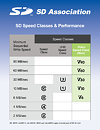Thursday, February 25th 2016
New SD Association Video Speed Class Supports 8K and Multi-File Video Recording
The SD Association (SDA), a global ecosystem of companies setting industry-leading memory card standards, today launched its fastest speed class, Video Speed Class, which also delivers real-time multi-file recording for many applications and supports the highest video resolutions and qualities available today. With Video Speed Class, 4K, 8K, 3D and 360 degree video recordings are now assured and accessible to consumers and professionals alike. Consumers will easily capture memories at their devices' best quality by following device manufacturer recommendations and matching the Video Speed Class mark on their device to an SD memory card with the same Video Speed Class mark. The new marks will appear on SDHC and SDXC UHS-I and UHS-II memory cards.
The new Video Speed Class maintains the tradition of ensuring guaranteed minimum performance levels as the familiar Speed Class and UHS Speed Class systems do today. Minimum speeds will range from 6MB to 90 MB per second. The fastest options, V60 and V90, support 8K resolution, while V6, V10 and V30 capture high-definition and 4K resolution. All speed classes guarantee minimum video recording speeds to ensure smooth video playback, so actual recording performance may be even faster.
"With Video Speed Class, SD device and memory card manufacturers can offer the highest-quality video recording to consumers and professionals that keep pace with the awesome video resolutions not only offered today, but anticipated tomorrow," said Brian Kumagai, president of the SDA. "New products leveraging the capabilities of Video Speed Class will be based on the high storage capacities offered by SDHC and SDXC memory cards."Video Speed Class, part of the latest SD 5.0 specification, gives SD manufacturers flexibility in using the latest flash memory technology to support a range of current and expected video applications. SDA anticipates and encourages market transition to the newly introduced Video Speed Class as the choice for future applications. The SDA expects video recording device and card manufacturers will offer the first products supporting Video Speed Class soon. Video Speed Class marks will be located on supporting devices and memory cards, product manuals or packages so consumers will know what type of card should match their device, assuring their video is recorded at their devices' highest quality with the best playback.
A new white paper, "Video Speed Class: The new capture protocol of SD 5.0," outlines how the latest SD specification enables Video Speed Class. Download the white paper at this page.
Visit the SD Association at CP+2016 in Booth G-O6 Thursday, Feb. 25, through Sunday, Feb. 28, to discuss the Video Speed Class for the next SD memory cards and video recording devices. SDA members will also demonstrate applications currently in the market, including UHS-I and UHS-II memory cards and devices, wireless SD memory card data transfers, TransferJet technology and more.
The new Video Speed Class maintains the tradition of ensuring guaranteed minimum performance levels as the familiar Speed Class and UHS Speed Class systems do today. Minimum speeds will range from 6MB to 90 MB per second. The fastest options, V60 and V90, support 8K resolution, while V6, V10 and V30 capture high-definition and 4K resolution. All speed classes guarantee minimum video recording speeds to ensure smooth video playback, so actual recording performance may be even faster.
"With Video Speed Class, SD device and memory card manufacturers can offer the highest-quality video recording to consumers and professionals that keep pace with the awesome video resolutions not only offered today, but anticipated tomorrow," said Brian Kumagai, president of the SDA. "New products leveraging the capabilities of Video Speed Class will be based on the high storage capacities offered by SDHC and SDXC memory cards."Video Speed Class, part of the latest SD 5.0 specification, gives SD manufacturers flexibility in using the latest flash memory technology to support a range of current and expected video applications. SDA anticipates and encourages market transition to the newly introduced Video Speed Class as the choice for future applications. The SDA expects video recording device and card manufacturers will offer the first products supporting Video Speed Class soon. Video Speed Class marks will be located on supporting devices and memory cards, product manuals or packages so consumers will know what type of card should match their device, assuring their video is recorded at their devices' highest quality with the best playback.
A new white paper, "Video Speed Class: The new capture protocol of SD 5.0," outlines how the latest SD specification enables Video Speed Class. Download the white paper at this page.
Visit the SD Association at CP+2016 in Booth G-O6 Thursday, Feb. 25, through Sunday, Feb. 28, to discuss the Video Speed Class for the next SD memory cards and video recording devices. SDA members will also demonstrate applications currently in the market, including UHS-I and UHS-II memory cards and devices, wireless SD memory card data transfers, TransferJet technology and more.

3 Comments on New SD Association Video Speed Class Supports 8K and Multi-File Video Recording
At least this time around they came up with labelling that makes a direct correlation to the speed in MB/s, rather than x times faster than a single speed CD drive of whatever it was we started with...
Same nonsense with DDR RAM in the past. Those bandwidth ratings instead of just calling it what clock it is like we again are doing now.
Keep the shit simple, using some fancy ratings was never useful and just further confused users instead of helping them.